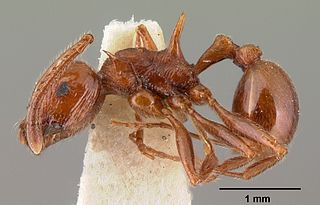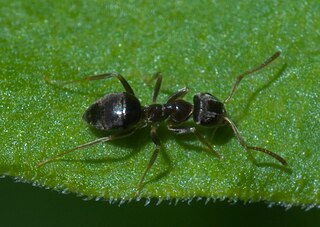
Ponerinae, the ponerine ants, is a subfamily of ants in the Poneromorph subfamilies group, with about 1,600 species in 47 extant genera, including Dinoponera gigantea - one of the world's largest species of ant. Mated workers have replaced the queen as the functional egg-layers in several species of ponerine ants. In such queenless species, the reproductive status of workers can only be determined through ovarian dissections.

Tapinoma is a genus of ants that belongs to the subfamily Dolichoderinae. The genus currently comprises 74 described species distributed worldwide in tropical and temperate regions. Members of are generalized foragers, nesting in a wide variety of habitats, ranging from grasslands, open fields, woodlands, to inside buildings. The majority of species nest in the ground under objects such as stones or tree logs, other species build nests under bark of logs and stumps, in plant cavities, insect galls or refuse piles.

Acropyga is a genus of small formicine ants. Some species can be indirect pests. A. acutiventris, which is found from India to Australia, tends subterranean, root-feeding mealybugs of the species Xenococcus annandalei. Living, gravid females are carried in the jaws of A. acutiventris queens during their nuptial flight, to establish the symbiotic association in founding colonies. Other Acropyga species have relationships with different species of mealybugs, and it could be a trait common to the whole genus.

Anochetus is a genus of small, carnivorous ants found in the tropics and subtropics throughout the world.
Pheidole bula is a species of ant in the genus Pheidole. It was discovered in Fiji, and described by E. M. Sarnat in 2008.
Pheidole simplispinosa is a species of ant native to the forests of Fiji.

Myrmecina is a genus of ants in the subfamily Myrmicinae. It contains 53 species distributed in North America, Europe, northern Africa, India, Korea, Japan and Australia.

Platythyrea is a genus of predaceous ants in the subfamily Ponerinae and the sole member of the tribe Platythyreini.

Technomyrmex is a genus of ants in the subfamily Dolichoderinae. With 98 species, it is one of the largest and most diverse ant genera in the Dolichoderinae. The genus distributed throughout the tropical and subtropical zones with most species occurring in the Oriental-Malesian and Afrotropical regions. One species, Technomyrmex albipes is a tramp ant now widespread throughout the tropics due to human activities.

Pristomyrmex is a genus of ants in the subfamily Myrmicinae.

Paraparatrechina is a genus of small ants in the subfamily Formicinae. The genus contains 39 species distributed in the tropics of Africa, Asia and Australia.

Meranoplus is an Old World genus of ants in the subfamily Myrmicinae. With over 80 valid species, it is predicted that over half of the Meranoplus diversity remains undescribed, most of these from Australia.
Lordomyrma vanua is a species of ant in the subfamily Myrmicinae.

Lordomyrma reticulata is a species of ant in the subfamily Myrmicinae.

Parasyscia is a genus of ants in the subfamily Dorylinae containing approximately 50 described species. The genus is distributed across the Afrotropical, Australasia, Indomalaya, Malagasy, Oceania, and Palearctic bioregions. Parasyscia was described by Carlo Emery (1882), moved to a subgenus of Cerapachys by Forel (1892) and finally placed as a junior synonym of Cerapachys by Kempf (1972). Parasyscia was resurrected as a valid genus by Borowiec (2016) during the redescription of the doryline genera.

Ectomomyrmex is a ponerine genus of ants found in Asia and Australia. Little is known about their biology, but they seem to be generalist predators of arthropod prey.

Pseudoneoponera is a ponerine genus of ants found from India to Australia, they are mostly queenless gamergate species, most of the species within the genus thrives on only gamergates.

Lasiini is a tribe of ants in the family Formicidae. There are about 10 genera and more than 450 described species in Lasiini.















